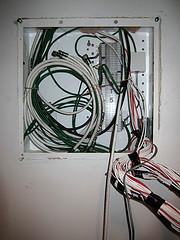
- Image by Lars Plougmann via Flickr
Last month, one of the things that went up on our cable bill was the rental of our cable box. It now costs over $14 a month to rent a cable box. Can it cost more than a year or two’s worth of rental fees to actually buy a box? Yet cable box manufacturers insist there is no market for direct consumer purchase of cable boxes, and thus the cable card system is nearly a failure.
At CES, Time Warner Cable announced that they had made a deal to make live and on demand programming available over IP, eliminating the need for a cable box. The new service will be integrated with Sony and Samsung TVs, as well as the Samsung Galaxy Tab. For now, this will only be available to customers who have their broadband services, but going forward, there is no reason why such a service could not be provided over any network.
Verizon FIOS has similar ambitions. it wants FIOS TV on everything from iPads to BluRay players.
Time Warner Cables CEO insists the demand for online-only viewing is small. We’re not so sure. A full online-only version of the offerings of a cable company has yet to be tried. Most online services have serious limitations in terms of content. Some of the biggest complaints about cord cutting has been the fact that no one service offers what the cable company does. That may become different if it is a cable company providing the service. or it may be that the cable company will do an inadequate job simply because they do not wish to challenge their core business.
What seems inevitable is a transition from conventional cable delivery systems to an IP based delivery system. The design of the HDHomeRun and the Ceton InfiniTV TV tuners are both IP based. Each decode the stream and stream it to the computer(although the Ceton device uses a virtual ethernet connection). Imagine a future where a cable box is installed in a single location in a house and multiple devices can access that box over your house network to stream channels, including your computer and your network-connected television.
The step beyond that is the so-called TV Anywhere, where you can access your content over the internet anywhere. That is what companies are looking at, but the concern is that bandwidth is not at the point at which high-quality streams can be sustained.
Either way, hopefully change is going to come, and this news is very promising.
Related articles
- Time Warner Cable VOD coming to Sony Bravia HDTVs, sans the cable box (engadget.com)
- Samsung will offer access to TV, VOD from Time Warner & Comcast on its Galaxy Tab, TVs (engadget.com)
- Could this be the year we get to ditch the cable box? (engadget.com)
- Why Time Warner Cable Is Cutting Its Own Cord (gigaom.com)
- CES 2011: Samsung adds Time Warner, DirecTV and Comcast to Smart TV initiative (blogs.consumerreports.org)
- How will cable and satellite handle the coming TV-internet union? (theglobeandmail.com)
